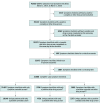Psychometric Performance of a Substance Use Symptom Checklist to Help Clinicians Assess Substance Use Disorder in Primary Care
- PMID: 37234003
- PMCID: PMC10220521
- DOI: 10.1001/jamanetworkopen.2023.16283
Psychometric Performance of a Substance Use Symptom Checklist to Help Clinicians Assess Substance Use Disorder in Primary Care
Abstract
Importance: Substance use disorders (SUDs) are underrecognized in primary care, where structured clinical interviews are often infeasible. A brief, standardized substance use symptom checklist could help clinicians assess SUD.
Objective: To evaluate the psychometric properties of the Substance Use Symptom Checklist (hereafter symptom checklist) used in primary care among patients reporting daily cannabis use and/or other drug use as part of population-based screening and assessment.
Design, setting, and participants: This cross-sectional study was conducted among adult primary care patients who completed the symptom checklist during routine care between March 1, 2015, and March 1, 2020, at an integrated health care system. Data analysis was conducted from June 1, 2021, to May 1, 2022.
Main outcomes and measures: The symptom checklist included 11 items corresponding to SUD criteria in the Diagnostic and Statistical Manual for Mental Disorders (Fifth Edition) (DSM-5). Item response theory (IRT) analyses tested whether the symptom checklist was unidimensional and reflected a continuum of SUD severity and evaluated item characteristics (discrimination and severity). Differential item functioning analyses examined whether the symptom checklist performed similarly across age, sex, race, and ethnicity. Analyses were stratified by cannabis and/or other drug use.
Results: A total of 23 304 screens were included (mean [SD] age, 38.2 [5.6] years; 12 554 [53.9%] male patients; 17 439 [78.8%] White patients; 20 393 [87.5%] non-Hispanic patients). Overall, 16 140 patients reported daily cannabis use only, 4791 patients reported other drug use only, and 2373 patients reported both daily cannabis and other drug use. Among patients with daily cannabis use only, other drug use only, or both daily cannabis and other drug use, 4242 (26.3%), 1446 (30.2%), and 1229 (51.8%), respectively, endorsed 2 or more items on the symptom checklist, consistent with DSM-5 SUD. For all cannabis and drug subsamples, IRT models supported the unidimensionality of the symptom checklist, and all items discriminated between higher and lower levels of SUD severity. Differential item functioning was observed for some items across sociodemographic subgroups but did not result in meaningful change (<1 point difference) in the overall score (0-11).
Conclusions and relevance: In this cross-sectional study, a symptom checklist, administered to primary care patients who reported daily cannabis and/or other drug use during routine screening, discriminated SUD severity as expected and performed well across subgroups. Findings support the clinical utility of the symptom checklist for standardized and more complete SUD symptom assessment to help clinicians make diagnostic and treatment decisions in primary care.
Conflict of interest statement
Figures


Similar articles
-
Test-retest reliability of DSM-5 substance use symptom checklists used in primary care and mental health care settings.Drug Alcohol Depend. 2024 Mar 1;256:111108. doi: 10.1016/j.drugalcdep.2024.111108. Epub 2024 Jan 24. Drug Alcohol Depend. 2024. PMID: 38295510 Free PMC article.
-
Practical Assessment of Alcohol Use Disorder in Routine Primary Care: Performance of an Alcohol Symptom Checklist.J Gen Intern Med. 2022 Jun;37(8):1885-1893. doi: 10.1007/s11606-021-07038-3. Epub 2021 Aug 16. J Gen Intern Med. 2022. PMID: 34398395 Free PMC article.
-
Routine Assessment of Symptoms of Substance Use Disorders in Primary Care: Prevalence and Severity of Reported Symptoms.J Gen Intern Med. 2020 Apr;35(4):1111-1119. doi: 10.1007/s11606-020-05650-3. Epub 2020 Jan 23. J Gen Intern Med. 2020. PMID: 31974903 Free PMC article.
-
Adolescents and substance-related disorders: research agenda to guide decisions on Diagnostic and Statistical Manual of Mental Disorders, fifth edition (DSM-V).Addiction. 2006 Sep;101 Suppl 1:115-24. doi: 10.1111/j.1360-0443.2006.01594.x. Addiction. 2006. PMID: 16930168 Review.
-
Behavioural modification interventions for medically unexplained symptoms in primary care: systematic reviews and economic evaluation.Health Technol Assess. 2020 Sep;24(46):1-490. doi: 10.3310/hta24460. Health Technol Assess. 2020. PMID: 32975190 Free PMC article.
Cited by
-
Equivalence of Alcohol Use Disorder Symptom Assessments in Routine Clinical Care When Completed Remotely via Online Patient Portals Versus In Clinic via Paper Questionnaires: Psychometric Evaluation.J Med Internet Res. 2024 Jul 22;26:e52101. doi: 10.2196/52101. J Med Internet Res. 2024. PMID: 39038284 Free PMC article.
-
Test-retest reliability of DSM-5 substance use symptom checklists used in primary care and mental health care settings.Drug Alcohol Depend. 2024 Mar 1;256:111108. doi: 10.1016/j.drugalcdep.2024.111108. Epub 2024 Jan 24. Drug Alcohol Depend. 2024. PMID: 38295510 Free PMC article.
-
Primary Care Patients With Opioid Use Disorder Symptoms: Initiation and Engagement in Treatment With Medicine.Ann Fam Med. 2025 Jul 28;23(4):308-314. doi: 10.1370/afm.240440. Ann Fam Med. 2025. PMID: 40721326 Free PMC article.
-
Feasibility, Engagement, and Usability of a Remote, Smartphone-Based Contingency Management Program as a Treatment Add-On for Patients Who Use Methamphetamine: Single-Arm Pilot Study.JMIR Form Res. 2023 Jul 6;7:e47516. doi: 10.2196/47516. JMIR Form Res. 2023. PMID: 37410529 Free PMC article.
-
Using digitally delivered measurement-based care in substance use disorder treatment: qualitative analysis of patients' perspectives.Am J Drug Alcohol Abuse. 2025;51(3):317-327. doi: 10.1080/00952990.2025.2458626. Epub 2025 Feb 24. Am J Drug Alcohol Abuse. 2025. PMID: 39992982
References
-
- Substance Abuse and Mental Health Services Administration . Key substance use and mental health indicators in the United States: results from the 2020 National Survey on Drug Use and Health. 2021. Accessed April 26, 2023. https://www.samhsa.gov/data/sites/default/files/reports/rpt35325/NSDUHFF...
-
- Substance Abuse and Mental Health Services Administration . Results from the 2020 National Survey on Drug Use and Health: detailed tables. 2021. Accessed April 26, 2023. https://www.samhsa.gov/data/report/2020-nsduh-detailed-tables
-
- American Psychiatric Association . Diagnostic and Statistical Manual of Mental Disorders. 5th ed. American Psychiatric Association; 2013.

